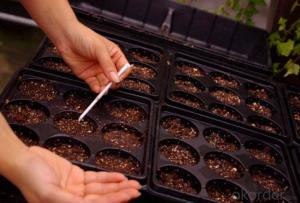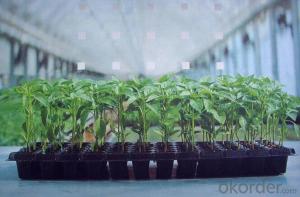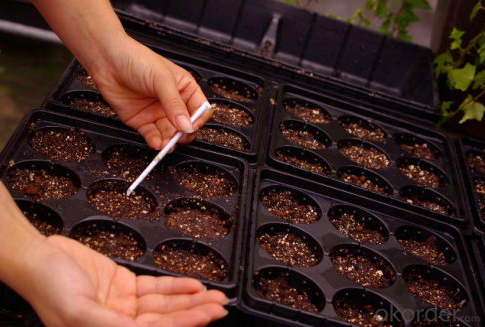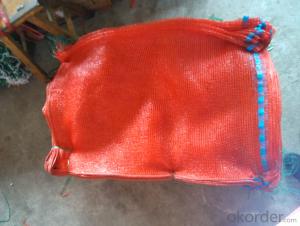Black Plastic Nursery Plug Trays Cell Seed Tray of 32 200 288
- Loading Port:
- China main port
- Payment Terms:
- TT OR LC
- Min Order Qty:
- 3000 pc
- Supply Capability:
- 2000000 pc/month
OKorder Service Pledge
OKorder Financial Service
You Might Also Like
Specification of Plug Trays HIPS Made Plastic Plug Tray for Greenhouse (Growing and Seedling):

Features of Plug Trays HIPS Made Plastic Plug Tray for Greenhouse (Growing and Seedling):
· Material: HIPS
· Thickness: 0.5mm-1.5mm, Standard:1mm
· Weight: 80g(±5)g-230g(±5)g, Standard weight:155g(±5)g
· Size: length:490mm-540mm, width:190mm-345mm,depth:25mm-150mm
· Standard:540mmX280mm
· Cell count: 18-512
· Package: In Carton
· Warrenty: 8-10 times
Packaging & Delivery
Packing Detail: export standard carton or large bags
Delivery time: 4 million per momth after receipt of deposit
Advantage:
Waterproof, UV-resistant, extrusion-resistant
Easy carry for young seeding plant and grow
Service:
1. Quick, efficient and professional response within 24 hours, 14 hours online services
2. 10 years manufacturing and exporting experience in agriculture field.
3. Technical support and solution by chief engineer.
4. Strict quality control system & team, high reputation in the market.
5. Full range of irrigation products for choice
6. OEM/ODM services
7. Accept sample order before Mass Order
Picture of Plug Trays HIPS Made Plastic Plug Tray for Greenhouse (Growing and Seedling):
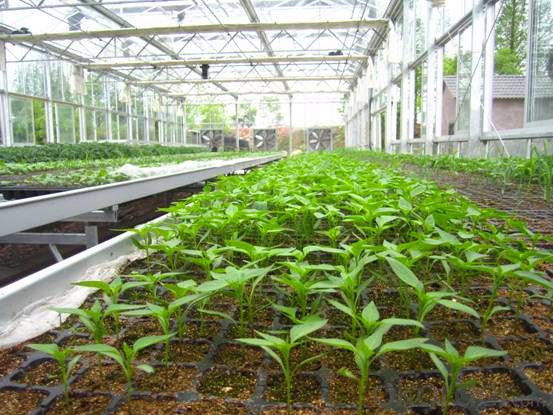

FAQ of Plug Trays HIPS Made Plastic Plug Tray for Greenhouse (Growing and Seedling):
Q: 1.How long is the production time?
A: Usually one to two weeks.
Q: 2.How is the seed tray being packaged?
A: They can be packaged in carton or pallets. Carton size is 1375px*725px*1250px.
Q:3.How many times can the seed tray be used?
A: Under the same environment, it is decided by the thickness. Usually 0.6mm thickness can be used for 1 or 2 times.
1.0 thickness can be used for 3-4 times. 1.5 thickness can be used for 8-10 times.
- Q: What is the best ground cover for controlling erosion on slopes?
- One of the best ground covers for controlling erosion on slopes is the use of erosion control blankets or mats. These blankets are made of biodegradable materials such as straw, coconut fiber, or jute, which provide immediate protection while allowing vegetation to establish and stabilize the soil. They help to reduce water runoff, prevent soil erosion, and promote the growth of native plants, making them an effective and environmentally friendly solution for slope erosion control.
- Q: what is the difference in texture that you get with plastic canvas yarn vs worsted yarn?
- It okorder
- Q: What are the different types of plastic buckets used in agriculture?
- There are several types of plastic buckets commonly used in agriculture, including feed buckets, water buckets, milk buckets, and grain buckets. Each type serves a specific purpose, such as storing and transporting animal feed, watering livestock, collecting milk from cows, or holding grains during harvesting. These buckets are made from durable and food-grade plastic materials to ensure long-lasting use and maintain hygiene standards in agricultural settings.
- Q: How does ground cover affect the growth of nearby vegetables?
- Ground cover can have a significant impact on the growth of nearby vegetables. In addition to providing a protective barrier against weeds, it helps regulate soil temperature and moisture levels, reducing the need for excessive watering and preventing soil erosion. Ground cover also adds organic matter to the soil as it decomposes, improving its fertility and structure. Furthermore, some types of ground cover, like clover or legumes, can fix nitrogen in the soil, benefiting the growth of neighboring vegetables. Overall, ground cover plays a crucial role in promoting the health and productivity of nearby vegetables.
- Q: What are the rules or laws governing the disposal of used agricultural plastic film?
- <p>Yes, there are regulations on the disposal of used agricultural plastic film. These regulations vary by country and region, but they generally aim to reduce environmental pollution and promote recycling. For instance, in the European Union, Directive 94/62/EC on packaging and packaging waste requires the reduction of packaging waste, including plastic film. In the United States, some states have specific laws, like California's娉曡, which mandates recycling or proper disposal of agricultural plastic film. Farmers and handlers are often required to collect and recycle used plastic film to prevent it from ending up in landfills or the environment. Violations can result in fines and penalties. It's important to check local regulations for specific disposal requirements and recycling programs.</p>
- Q: 1)Plastic surgery: Right or Wrong? Explain your answer.2)Would you ever consider plastic surgery?3)Would you get plastic surgery if it was free and completely safe?4)If you could get plastic surgery, what would you change and why?MY ANSWERS:1)I think that people should be aloud to get plastic surgery if they are 100% sure and that it would make them happy and secure with themselves.2)No.3)No.4)I'd get butt implants :')I would never have it, I am the way God intended. :)
- Wrong...be natural and embrace your beauty you were blessed with =) Consider if I was a celebrity and in the spotlight all the time No I would change the price :)
- Q: Are nursery trays suitable for starting aquatic plant seedlings?
- No, nursery trays are not suitable for starting aquatic plant seedlings. Aquatic plants require special conditions such as being submerged in water, which nursery trays cannot provide.
- Q: Can ground cover prevent weeds from growing?
- Yes, ground cover can prevent weeds from growing. Ground cover plants form a dense and low-growing mat that shades the soil, making it difficult for weed seeds to germinate and grow. Additionally, ground cover plants compete with weeds for resources like sunlight, water, and nutrients, further inhibiting weed growth.
- Q: Are nursery trays suitable for starting cut flowers?
- Yes, nursery trays are suitable for starting cut flowers. They provide a controlled environment for the seeds to germinate and grow, allowing for easy transplanting once the plants are ready. The individual compartments in nursery trays also help in preventing overcrowding and allow for better root development, leading to healthier plants.
- Q: Can agricultural plastic products be used in vertical farming?
- Yes, agricultural plastic products can be used in vertical farming. They are commonly utilized for various purposes in vertical farming, such as constructing greenhouse structures, creating grow bags or containers for plants, and implementing irrigation systems. Plastic materials used in agriculture, such as polyethylene or polypropylene, provide durability, flexibility, and water resistance, making them suitable for vertical farming applications.
Send your message to us
Black Plastic Nursery Plug Trays Cell Seed Tray of 32 200 288
- Loading Port:
- China main port
- Payment Terms:
- TT OR LC
- Min Order Qty:
- 3000 pc
- Supply Capability:
- 2000000 pc/month
OKorder Service Pledge
OKorder Financial Service
Similar products
Hot products
Hot Searches
Related keywords
